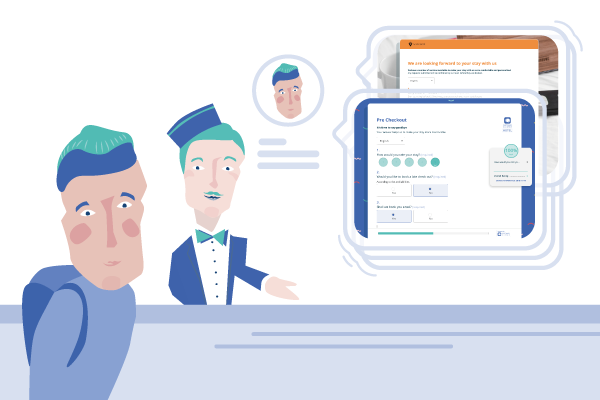
By Torsten Sabel
If you check in at the Henn na Hotel in Sasebo, Japan, you will be greeted by a dinosaur. Transport robots take your luggage to the room and the door opens via facial recognition. In Cologne’s Koncept Hotel, apart from housekeeping, you won’t see any staff member either. Booking, check-in, opening the room door and check-out – everything is done via smartphone.
Digitization Is Picking Up Speed
Even though the management in Japan has already shut down more than half of the 243 robots again, it is clear that digitization has gained momentum in the hotel industry. But whether online check-in or digital guest maps – many innovations are often treated negligently and skeptically by hoteliers. However, digital guest communication is the key to counteracting staff shortages, relieving the workload of employees and meeting guests’ expectations along the entire Guest Journey. Hoteliers should ask themselves which digital solutions bring advantage to their business and how they can be integrated in a useful way. A closer look at the target group also helps: Who are my guests? What are their needs and expectations?
The Right Balance Between Digital Tools and Personal Interaction
In general, there is no “one fits all” solution. Digital communication should always be in balance with the personal service on site, supporting and supplementing it. It’s about your unique identity as a host: the heart of the hotel business is and remains the personal interaction with guests. Along the Guest Journey, however, there are numerous contact points that can be positively influenced by the use of digital solutions:
Digital Pre-Stay Communication
Whether private hotel or international chain, a clear and up-to-date website is essential for every business. If you want to address a digital-affine target group, you should also maintain your presence on social media platforms.
To take it one step further, communicate with your guest prior to their arrival with an automated message. Answer the most frequently asked questions and provide some useful information about your hotel and the surrounding area. This service should be essential for every hotelier that wants to increase its guest satisfaction in the long term. In addition, such personalized pre-stay-emails are a useful tool to boost your revenue by offering a higher room category or a reservation in the restaurant. By using a pre-stay questionnaire, you can already collect all relevant data for the registration form. This reduces the effort for employees and shortens waiting times at the reception.
Hotel apps that combine different functions such as booking or a digital guest maps are also gaining more and more attention. But not every hotel should necessarily design its own app. Guests who are planning a single stay in your hotel hardly download an additional app. For international hotel chains with a large target group and extensive loyalty programs, however, this investment can be worthwhile.
Digital During-Stay Communication
Whether it’s a dripping tap or a broken light bulb, automated questionnaires allow guests to provide feedback conveniently from the comfort of their room via smartphone, WiFi or beacons. The requests can be processed before the guest departs and before receiving a negative review.
Digital guest maps have also proven to be useful in the everyday hotel life. However, do not only create an electronic copy of the print version, but use it to actively communicate with your guests via push messages.
A (completely) depersonalized solution like robots is currently not advisable. The technology is not yet mature enough to offer guests a true added value and to reduce the workload for employees. In a few years’ time, however, this could be of interest to hotels with a curious and technology-savvy target group.
Digital Post-Stay Communication
After your guests depart, it should be essential for every hotel to ask them for feedback with the help of individual questionnaires. Using the right questions and analysing the feedback thoroughly, hotels gain a better insight into the wishes of their guests and can optimize internal processes.
Conclusion
Digital communication is not about replacing personnel with robots, but about engaging with guests and enhancing their experience. In times of digitalization and staff shortages, the question is not whether to digitalize guest communication, but when and with which tools. Hoteliers should focus on solutions that help to design the digital guest journey and make stay of guests even more pleasant. Processes should be optimized and personnel relieved so that hoteliers can concentrate on the centerpiece of their business: taking care of their guests.


